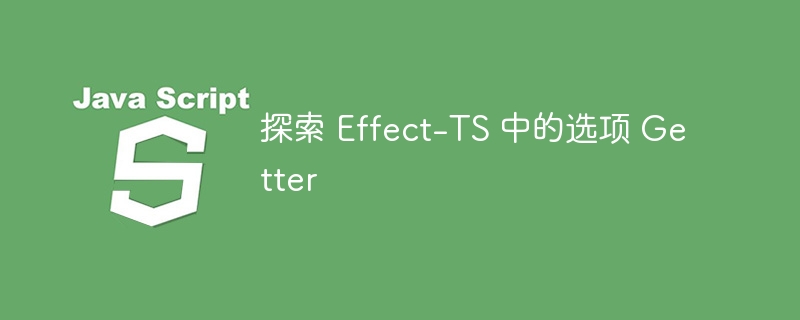探索 Effect-TS 中的选项 Getter
来源:dev.to
时间:2024-07-17 08:39:59 295浏览 收藏
本篇文章给大家分享《探索 Effect-TS 中的选项 Getter》,覆盖了文章的常见基础知识,其实一个语言的全部知识点一篇文章是不可能说完的,但希望通过这些问题,让读者对自己的掌握程度有一定的认识(B 数),从而弥补自己的不足,更好的掌握它。

effect-ts 提供了一组强大的工具来处理 option 类型,这些类型表示可能存在也可能不存在的值。在本文中,我们将探索使用库提供的不同 getter 获取 option 内的值的各种方法。
示例 1:使用 o.getorelse
o.getorelse 函数允许您在 option 为 none 时提供默认值。当您想确保后备值始终可用时,这非常有用。
import { option as o, pipe } from 'effect';
function getters_ex01() {
const some = o.some(1); // create an option containing the value 1
const none = o.none(); // create an option representing no value
console.log(pipe(some, o.getorelse(() => 'none'))); // output: 1 (since some contains 1)
console.log(pipe(none, o.getorelse(() => 'none'))); // output: 'none' (since none is none)
}
示例 2:使用 o.getorthrow
o.getorthrow 函数如果是 some,则返回 option 内部的值,否则抛出默认错误。
import { option as o, pipe } from 'effect';
function getters_ex02() {
const some = o.some(1); // create an option containing the value 1
const none = o.none(); // create an option representing no value
console.log(pipe(some, o.getorthrow)); // output: 1 (since some contains 1)
try {
console.log(pipe(none, o.getorthrow)); // this will throw an error
} catch (e) {
console.log(e.message); // output: getorthrow called on a none
}
}
示例 3:使用 o.getornull
o.getornull 函数如果是 some,则返回 option 内部的值,否则返回 null。
import { option as o, pipe } from 'effect';
function getters_ex03() {
const some = o.some(1); // create an option containing the value 1
const none = o.none(); // create an option representing no value
console.log(pipe(some, o.getornull)); // output: 1 (since some contains 1)
console.log(pipe(none, o.getornull)); // output: null (since none is none)
}
示例 4:使用 o.getorundefined
o.getorundefine 函数如果是 some,则返回 option 内部的值,否则返回 undefined。
import { option as o, pipe } from 'effect';
function getters_ex04() {
const some = o.some(1); // create an option containing the value 1
const none = o.none(); // create an option representing no value
console.log(pipe(some, o.getorundefined)); // output: 1 (since some contains 1)
console.log(pipe(none, o.getorundefined)); // output: undefined (since none is none)
}
示例 5:使用 o.getorthrowwith
import { Option as O, pipe } from 'effect';
function getters_ex05() {
const some = O.some(1); // Create an Option containing the value 1
const none = O.none(); // Create an Option representing no value
console.log(pipe(some, O.getOrThrowWith(() => new Error('Custom Error')))); // Output: 1 (since some contains 1)
try {
console.log(pipe(none, O.getOrThrowWith(() => new Error('Custom Error')))); // This will throw a custom error
} catch (e) {
console.log(e.message); // Output: Custom Error
}
}
结论
通过使用这些不同的 getter,您可以有效地处理各种场景中的 option 类型,确保您的代码无论 option 是 some 还是 none 都能正确运行。这些实用程序提供了一种清晰、类型安全的方式来处理可选值,避免了与空检查相关的常见陷阱,并增强了代码的可读性和可维护性。采用这些模式可以带来更干净、更健壮的代码库,其中
理论要掌握,实操不能落!以上关于《探索 Effect-TS 中的选项 Getter》的详细介绍,大家都掌握了吧!如果想要继续提升自己的能力,那么就来关注golang学习网公众号吧!
-
502 收藏
-
501 收藏
-
501 收藏
-
501 收藏
-
501 收藏
-
247 收藏
-
361 收藏
-
353 收藏
-
293 收藏
-
191 收藏
-
207 收藏
-
439 收藏
-
465 收藏
-
162 收藏
-
149 收藏
-
336 收藏
-
231 收藏
-

- 前端进阶之JavaScript设计模式
- 设计模式是开发人员在软件开发过程中面临一般问题时的解决方案,代表了最佳的实践。本课程的主打内容包括JS常见设计模式以及具体应用场景,打造一站式知识长龙服务,适合有JS基础的同学学习。
- 立即学习 543次学习
-

- GO语言核心编程课程
- 本课程采用真实案例,全面具体可落地,从理论到实践,一步一步将GO核心编程技术、编程思想、底层实现融会贯通,使学习者贴近时代脉搏,做IT互联网时代的弄潮儿。
- 立即学习 516次学习
-

- 简单聊聊mysql8与网络通信
- 如有问题加微信:Le-studyg;在课程中,我们将首先介绍MySQL8的新特性,包括性能优化、安全增强、新数据类型等,帮助学生快速熟悉MySQL8的最新功能。接着,我们将深入解析MySQL的网络通信机制,包括协议、连接管理、数据传输等,让
- 立即学习 500次学习
-

- JavaScript正则表达式基础与实战
- 在任何一门编程语言中,正则表达式,都是一项重要的知识,它提供了高效的字符串匹配与捕获机制,可以极大的简化程序设计。
- 立即学习 487次学习
-

- 从零制作响应式网站—Grid布局
- 本系列教程将展示从零制作一个假想的网络科技公司官网,分为导航,轮播,关于我们,成功案例,服务流程,团队介绍,数据部分,公司动态,底部信息等内容区块。网站整体采用CSSGrid布局,支持响应式,有流畅过渡和展现动画。
- 立即学习 485次学习
